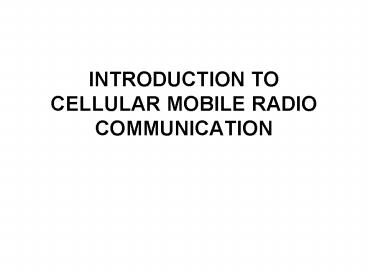INTRODUCTION TO CELLULAR MOBILE RADIO COMMUNICATION - PowerPoint PPT Presentation
INTRODUCTION TO CELLULAR MOBILE RADIO COMMUNICATION
An illustration of the cellular frequency reuse concept. ... Examples of monocycle waveforms that model pulses in impulse radio: Manchester pulse; ... – PowerPoint PPT presentation
Title: INTRODUCTION TO CELLULAR MOBILE RADIO COMMUNICATION
1
INTRODUCTION TO CELLULAR MOBILE RADIO
COMMUNICATION
2
An illustration of a cellular system.
3
An illustration of the cellular frequency reuse
concept.
4
FDMA scheme in which different users are assigned
different frequency bands.
5
TDMA scheme in which each user occupies a
cyclically repeating time slot.
6
A three-sectored antenna in a single isolated
cell.
7
Example of the transmission over an adding
channel, synchronous case.
8
The model of uplink transmission in the DS CDMA
system.
9
The model of the base station receiver of the DS
CDMA system.
10
Illustration of FSK slow-frequency-hopped spread
spectrum system
- transmitted signal
- dehopped signal (4-FSK modulation)
11
Illustration of FSK fast-frequency-hopped spread
spectrum system
- transmitted signal
- receiver down-converter output.
12
Illustration of FH
- (a) binary FSK transmission
- (b) FH CDMA transmission with two users.
13
Examples of monocycle waveforms that model pulses
in impulse radio
- Manchester pulse
- differentiated Gaussian pulse.
14
1.14. Illustration of PPH CDMA transmission.
15
Receiver structure for BPSK.
PowerShow.com is a leading presentation sharing website. It has millions of presentations already uploaded and available with 1,000s more being uploaded by its users every day. Whatever your area of interest, here you’ll be able to find and view presentations you’ll love and possibly download. And, best of all, it is completely free and easy to use.
You might even have a presentation you’d like to share with others. If so, just upload it to PowerShow.com. We’ll convert it to an HTML5 slideshow that includes all the media types you’ve already added: audio, video, music, pictures, animations and transition effects. Then you can share it with your target audience as well as PowerShow.com’s millions of monthly visitors. And, again, it’s all free.
About the Developers
PowerShow.com is brought to you by CrystalGraphics, the award-winning developer and market-leading publisher of rich-media enhancement products for presentations. Our product offerings include millions of PowerPoint templates, diagrams, animated 3D characters and more.































